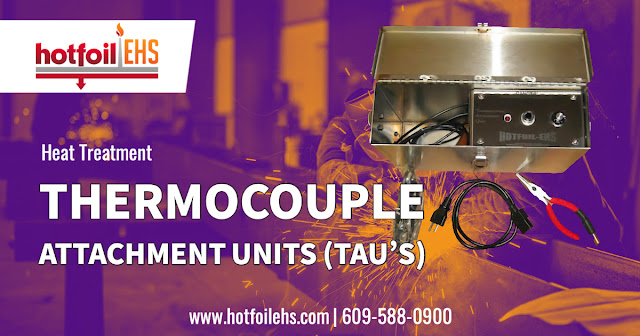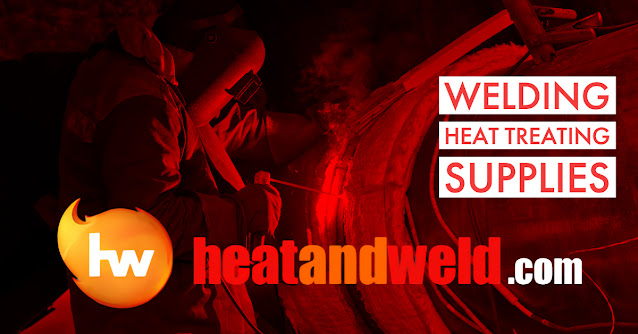A blog that provides educational information on electric heating systems used on hoppers, chutes, tanks and vessels; electric heating systems used for pre and post weld heat treating; heat treating power consoles; custom heat treating furnaces; and single & multi-operator welders. For more information, visit HotfoilEHS.com
Understanding the Importance of Ceramic Mat Heaters in Pre-Weld Heating Applications
Thermocouple Attachment Units in Heat Treatment
Thermocouples play a crucial role in the heat treatment industry, particularly welding. A thermocouple is a type of sensor consisting of two different types of metal joined together at one end. When the joined end is heated or cooled, it creates a micro voltage correlated to the temperature.
The Thermocouple Attachment Unit (TAU) is a crucial device used to construct and apply these thermocouples to the workpieces or target pieces that will be welded.
Construction of Thermocouples:
- Preparation of Thermocouple Wire: The first step in constructing a thermocouple involves preparing the thermocouple wire. These wires are two different types of metal, with their choice depending on the temperature range and the environmental conditions of the process.
- Joining the Wires: The two thermocouple wires connect at one end by twisting the two wires together and then applying heat, generally through a method such as welding or brazing.
Application of Thermocouples to Welding Target Pieces:
- Location Selection: The thermocouples need to be attached strategically to effectively monitor the temperature of the workpiece during the welding process. These locations are generally where the thermal properties are most critical for the quality of the weld, such as the weld joint or near heat-affected zones.
- Attachment: The TAU is then used to attach the thermocouple to the selected location on the workpiece. The attachment is typically done by welding the bead of the thermocouple to the workpiece. The TAU can often control this process to ensure a good connection without damaging the thermocouple.
- Connection to Measurement Device: After attachment, the other end of the thermocouple is connected to a temperature measurement device or system. This device measures the thermocouple's voltage and translates it into a temperature reading.
During the welding process, the thermocouple provides real-time temperature data, helping to control the weld's heating and cooling rates, ensuring the weld reaches the appropriate temperatures without overheating or cooling too quickly, both of which can lead to weld defects. After the process, thermocouples can be removed or left in place, depending on the requirements.
Remember, the specific process can vary based on the type of TAU and the particular requirements of the welding operation. Always refer to the manufacturer's instructions when using a TAU.
https://hotfoilehs.com
609.588.0900
Hotfoil-EHS Power Consoles: Eurotherm Master Controller Set-up for PWHT Procedure
This video explains how to set up the Eurotherm Temperature Controller on a Hotfoil-EHS Power Console in a Primary/Secondary relationship.
Understanding heating rate, soaking temperature, soaking time and cooling rate for PWHT (Post Weld Heat Treatment)
Post-weld heat treatment (PWHT) is a crucial step in the welding process, as it helps to mitigate the adverse effects of welding on the microstructure and mechanical properties of the welded components. The main objectives of PWHT are to reduce residual stresses, improve ductility, reduce the risk of stress corrosion cracking, and temper or soften the heat-affected zone (HAZ). The four key factors that influence the effectiveness of PWHT are heating rate, soaking temperature, soaking time, and cooling rate.
- Heating rate: The heating rate refers to the rate at which the temperature of the welded component increases to reach the desired soaking temperature. A controlled and uniform heating rate is essential to avoid the formation of undesirable temperature gradients within the material, which can lead to distortion and cracking. A slow, steady heating rate also ensures that the material undergoes sufficient thermal stress relief, reducing residual stresses and improving the mechanical properties.
- Soaking temperature: The soaking temperature is the target temperature at which the material stays during the heat treatment. The selection of an appropriate soaking temperature is vital, as it determines the extent of stress relief, the softening of the HAZ, and the overall improvement of mechanical properties. The soaking temperature is carefully chosen based on the material's composition, prior heat treatment, and the desired outcomes of the PWHT. Too high a temperature may cause grain coarsening and reduce the material's strength, while too low a temperature may not provide adequate stress relief or soften.
- Soaking time refers to the duration the material holds at the soaking temperature. The soaking time is critical for allowing sufficient time for the microstructural changes to occur, such as diffusion of hydrogen, precipitation of carbides, or tempering of martensite. Proper soaking time reduces residual stresses and improves ductility and the desired microstructural changes. Insufficient soaking time can lead to incomplete stress relief, while excessive soaking time may result in grain coarsening, which can adversely affect the material's mechanical properties.
- Cooling rate: The cooling rate is the rate at which the temperature of the material reduces after the completion of the soaking phase. The cooling rate significantly influences the material's final microstructure and mechanical properties. Controlled and uniform cooling is essential to prevent thermal gradients that could cause distortion or cracking. Different cooling rates may be required depending on the material and the desired outcome. Faster cooling may achieve a harder, more robust microstructure, while slower cooling rates can produce a more ductile, softer material.
In summary, the heating rate, soaking temperature, soaking time, and cooling rate are essential parameters requiring careful controlling during post-weld heat treatment. These factors determine the effectiveness of the heat treatment process in reducing residual stresses, improving ductility, reducing the risk of stress corrosion cracking, and achieving the desired microstructure and mechanical properties in the welded components.
Welding Pre and Post Heat Treatment Power Consoles
What is Post Weld Heat Treatment?
- Electric heating: This method involves using electric resistance heaters to heat the component to the required temperature.
- Gas heating: This method involves using gas burners or a gas-fired furnace to heat the component.
- Induction heating: This method involves using an induction coil to generate an alternating current in the component, which creates heat through resistive heating.
- Box Furnaces: These are the most common type of furnace used for post weld heat treatment. They are typically made of steel and are insulated to retain heat. They can be heated by gas, electricity, or oil, and are often used for small to medium-sized parts.
- Pit Furnaces: These are similar to box furnaces, but are sunken into the ground. They are used for larger parts and are often used for heat treatment of steel plates and structural steel.
- Continuous Furnaces: These are used for heat treating large quantities of parts. They consist of a conveyor system that moves the parts through the furnace.
- Car-Bottom Furnaces: These are similar to pit furnaces, but are raised off the ground and have a car-bottom design. They are used for heat treating large, heavy parts, such as castings and forgings.
- Atmosphere Controlled Furnace: This type of furnace is used to control the atmosphere inside the furnace during heat treatment. This is useful to prevent oxidation of the parts.





